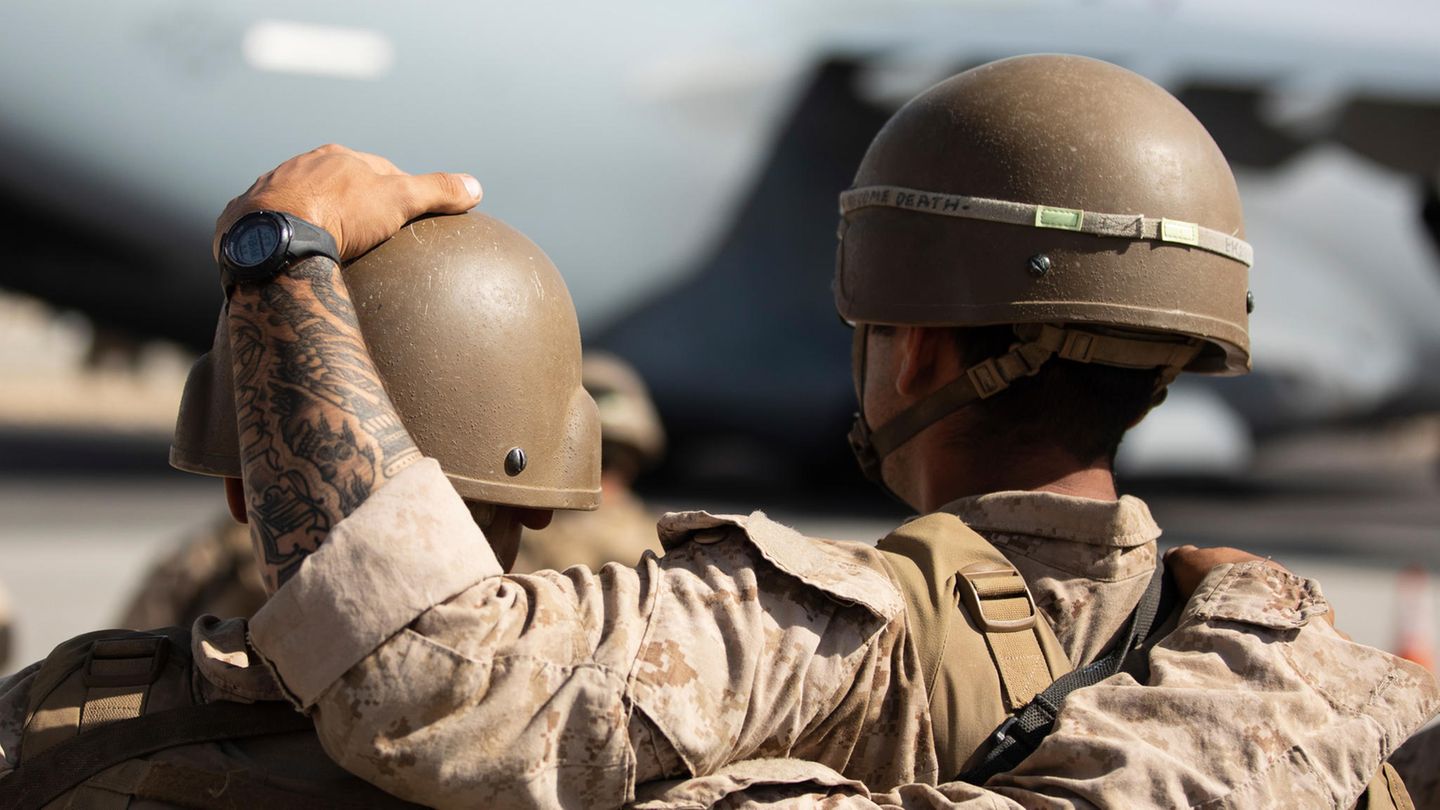The last US soldier has left the country and the international mission in Afghanistan ends in disaster. The West leaves the field to the Taliban. Was it all for nothing?
Hundreds of thousands of soldiers from dozens of countries, Western aid in the billions, an unprecedented feat of strength by the international community – and yet the Taliban are again in power in Afghanistan. With the departure of the last US soldiers from Kabul airport, the international Afghanistan mission came to an end on Tuesday night. The West is now leaving the country back to the Islamists it had ousted at the end of 2001. What remains after almost 20 years of use?
The west failed
An Islamist force, armed primarily with Russian assault rifles and bazookas, prevailed against the superpower USA and its allies, which at times had more than 100,000 international soldiers on duty. On the 20th anniversary of the Al Qaeda attacks of September 11, 2001 – which sparked the US-led invasion of Afghanistan – the Taliban’s white flag is flying over Kabul again. Chancellor Angela Merkel admitted that, beyond the fight against terrorism, everything “was not as successful and not as we had set out to do”. “That is a realization that is bitter.”
Al Qaeda is weakened
US President Joe Biden argues that the main objective of the operation was achieved with the killing of Al Qaeda boss Osama Bin Laden a good ten years ago at the latest. The organization is weakened and, in fact, the US has not suffered a similar terrorist attack since September 11, 2001. The Taliban’s victory is also a later triumph for al-Qaeda, and the organization is still present in large parts of Afghanistan. Guido Steinberg, terrorism expert at the Berlin-based Science and Politics Foundation (SWP), says: “Al-Qaeda has taken power together with the Taliban.”
Jihadists around the world are encouraged
Steinberg speaks of a “wake-up call for the global jihadist movement”. Supporters of radical and violent groups are likely to feel confirmed in their view that they only have to hold out until the West runs out of patience – the Taliban have shown the way. This could also bring new influx of the terrorist militia Islamic State (IS) (which is hostile to the Taliban). IS cells are active in Afghanistan, but also in Syria and Iraq – sooner or later the withdrawal of US troops will also be up for debate in these countries.
Confidence in the USA has been shaken
This applies on several levels: The European allies have had to experience that Biden preaches partnership, but – like his predecessor Donald Trump – decides alone on key issues. This applied to the withdrawal of troops as well as to the evacuation mission. Above all, however, those Afghans who believed the promise that the West would not let them down are disaffected. Most recently, the US-allied Kurds in northern Syria suffered a similar fate: Trump withdrew a large part of the US troops from this region in 2019, while Russian President Vladimir Putin is firmly on the side of Syrian ruler Bashar al-Assad.
China and Russia are strengthened
While Western citizens fled after the Taliban came to power, Russia and China kept their embassies open in Kabul. Taliban deputy chief Mullah Ghani Baradar, who is being traded as a possible future head of government in Kabul, was received in Moscow and Beijing in July. In 1989 the Red Army withdrew unsuccessfully from Afghanistan, now the Americans have failed there too – balm for Russian self-confidence. China, on the other hand, sees itself as a coming superpower – and the USA on the decline.
Biden is battered
In the days of chaos surrounding the withdrawal and the evacuations, Biden clearly lost approval. According to the statisticians of the website FiveThirtyEight, who compile and weight surveys, for the first time more people are dissatisfied than satisfied with his administration. According to all surveys, a majority of Americans believe the withdrawal of US troops to be correct. A majority also attested Biden bad management in his worst foreign policy crisis to date. Biden himself does not admit any mistakes.
The Bundeswehr learned to fight
The Bundeswehr site was initially mocked as “Bad Kunduz”, but the calm in northern Afghanistan should not last long. The Taliban gained strength, German soldiers were killed – and Bundeswehr soldiers killed their opponents in combat. The image of the well drill in uniform, which some politicians would have liked to cultivate, soon no longer had much to do with reality. How difficult it was for politicians in Berlin to cope with the new role of the Bundeswehr was exemplified by the discussion in 2009 about whether Germany was involved in a “war” in Afghanistan – or just in an “armed conflict”.
The toll was enormous
The mission in Afghanistan cost more than 3,500 foreign soldiers their lives, among them 59 Germans. Of the international troops, the United States suffered by far the heaviest casualties, with more than 2,460 US soldiers dying in America’s longest war. It is estimated that more than 45,000 members of the Afghan security forces were killed, and tens of thousands of Taliban fighters are also believed to have lost their lives. More than 40,000 civilians have been killed since the United Nations census began in 2009 alone.
The cost was huge
At times, the US operation cost more than 100 billion dollars a year (almost 85 billion euros). As the number of troops decreased, the costs decreased. For the reconstruction of Afghanistan, the US had budgeted a total of more than 143 billion dollars over the past 20 years, more than 88 billion dollars of which will benefit the Afghan security forces. The Bundeswehr mission in Afghanistan has cost more than twelve billion euros since the end of 2001. In addition, the federal government paid several hundred million euros every year for humanitarian aid, development aid and reconstruction in Afghanistan.

There has been progress in Afghanistan
In the disengagement chaos, the fact that much has been achieved in Afghanistan in recent years has faded into the background. Two of many examples: The average life expectancy has risen from 56 years in 2001 to the last 63 years, the number of schoolchildren has grown from 900,000 (boys only) to 9.5 million (almost 40 percent of them girls). It is unclear which achievements will survive the new version of the Taliban regime, especially when it comes to women’s rights. How the world will find out what will happen in Afghanistan in the future is also open. At least there is hope that the Islamists will not be able to completely seal off Afghanistan again – cell phone networks are well developed and smartphones are widespread.
David William is a talented author who has made a name for himself in the world of writing. He is a professional author who writes on a wide range of topics, from general interest to opinion news. David is currently working as a writer at 24 hours worlds where he brings his unique perspective and in-depth research to his articles, making them both informative and engaging.




